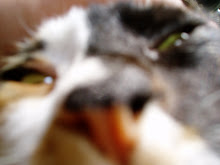Hōsen(zen)ji 法泉(禅)寺 was built in 1330 by Takeda Nobutake 武田信武 (1292-1359). He invited Gesshū zenji 月舟禅師 who was one of the leading disciples of
Musō Soseki 夢窓疎石 (1275-1351), also known as Musō Kokushi 夢窓国師, as the resident priest*. This temple is famous for the tomb of
Takeda Katsuyori 武田勝頼 (1546-1582). After
Shingen's death (1573), Katsuyori took over as head of the Takeda's family, but the clan was defeated by the coalition troops of
Oda Nobunaga 織田信長 and
Tokugawa Ieyasu 徳川家康 at
the Battle of Nagashino 長篠の戦い (1575) and then was declining. In 1582, Katsuyori, the family and the remaining subordinates suffered defeat to the combined forces at
the Battle of Temmokuzan 天目山の戦い and he and his family commited suicide. Then Nobunaga ordered to put Katsuyori's head on public display at the Rokujō-gawara 六条河原 (known as an execution ground) in Kyoto. Kaigaku 快岳, the resident priest of Hōsenji at the time, knew that and brought the head back to the temple. And he built Katsuyori's tomb.
*Gesshū declined to be Kaizan, the first resident priest, of Hōsenji, asked his master Soseki to be it and became the second.

Shōrōmon 鐘楼門, built in 1636.

Garden lanterns and Hondō 本堂, built in 1680.

One of 16 Arhat Statues

Kongōfukujusan 金剛福聚山

■
Hosenji's Official Web Site (Japanese version only)
■ View
Kongōfukujusan Hōsenzenji 金剛福聚山 法泉禅寺 on Google My Maps
■ Refer to
Kofu-Gozan & Kai Zenkoji and
Kai Pilgrimage■ Reference Data
・Hosenji's Official Web Site
・Wikipedia





















I want to visit Japan. Your blog just brought me there!^^
ReplyDeleteThank you for visiting my site. When you come to Japan, please visit Yamanashi.
ReplyDelete